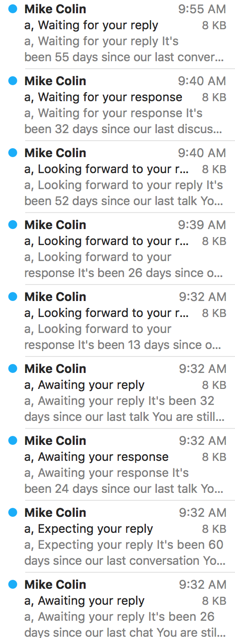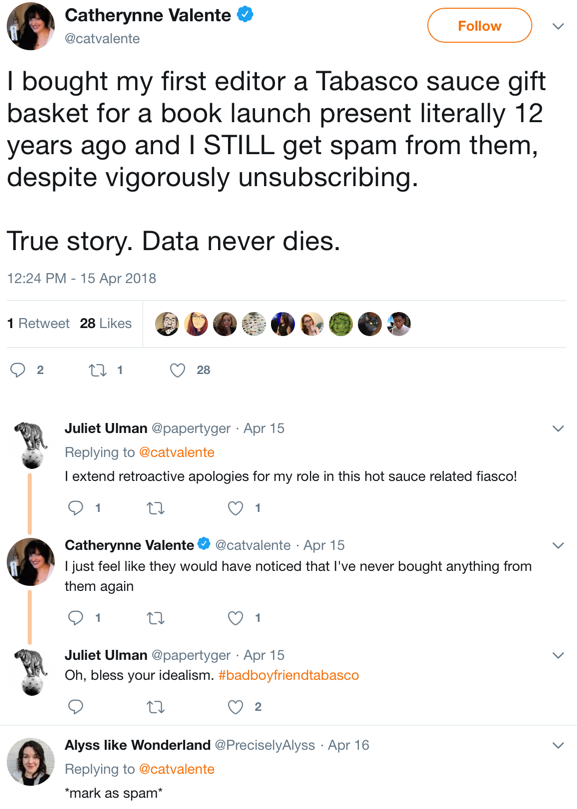Related Posts
Would you buy a used car from that guy?
- laura
- Oct 20, 2010
There are dozens of people and companies standing up and offering suggestions on best practices in email marketing. Unfortunately, many of those companies don’t actually practice what they preach in managing their own email accounts.
I got email today to an old work email address of mine from Strongmail. To be fair it was a technically correct email. Everything one would expect from a company handling large volumes of emails. It’s clear that time and energy was put into the technical setup of the send. If only they had put even half that effort into deciding who to send the email to. Sadly, they didn’t.
My first thought, upon receiving the mail, was that some new, eager employee bought a very old and crufty list somewhere. Because Strongmail has a reputation for being responsible mailers, I sent them a copy of the email to abuse@. I figured they’d want to know that they had a new sales / marketing person who was doing some bad stuff.
I know how frustrating handling abuse@ can be, so I try to be short and sweet in my complaints. For this one, I simply said, “Someone at Strongmail has appended, harvested or otherwise acquired an old email address of mine. This has been added to your mailing list and I’m now receiving spam from you. ”
They respond with an email that starts with:
“Thank you for your thoughtful response to our opt-in request. On occasion, we provide members of our database with the opportunity to opt-in to receive email marketing communications from us.”
Wait. What? Members of our database? How did this address get into your database?
“I can’t be sure from our records but it looks like someone from StrongMail reached out to you several years ago. It’s helpful that you let us know to unsubscribe you. Thank you again.”
There you have it. According to the person answering email at abuse@ Strongmail they sent me a message because they had sent mail to me in the past. Is that really what you did? Send mail to very old email addresses because someone, at some point in the past, sent mail to that address? And you don’t know when, don’t know where the address came from, don’t know how it was acquired, but decided to reach out to me?
How many bad practices can you mix into a single send, Strongmail? Sending mail to addresses where you don’t know how you got them? Sending mail to addresses that you got at least 6 years ago? Sending mail to addresses that were never opted-in to any of your mail? And when people point out, gently and subtly, that maybe this is a bad idea, you just add them to your global suppression list?
Oh. Wait. I know what you’re going to tell me. All of your bad practices don’t count because this was an ‘opt-in’ request. People who didn’t want the mail didn’t have to do anything, therefore there is no reason not to spam them! They ignore it and they are dropped from your list. Except it doesn’t work that way. Double opt-in requests to someone has asked to be subscribed or is an active customer or prospect is one thing. Requests sent to addresses of unknown provenance are still spam.
Just for the record, I have a good idea of where they got my address. Many years ago Strongmail approached Word to the Wise to explore a potential partnership. We would work with and through Strongmail to provide delivery consulting and best practices advice for their customers. As part of this process we did exchange business cards with a number of Strongmail employees. I suspect those cards were left in a desk when the employees moved on. Whoever got that desk, or cleaned it out, found those cards and added them to the ‘member database.’
But wait! It gets even better. Strongmail was sending me this mail, so that they could get permission to send me email about Email and Social Media Marketing Best Practices. I’m almost tempted to sign up to provide me unending blog fodder for my new series entitled “Don’t do this!”
June 2016: The Month in Email
- laura
- Jul 6, 2016
We’re officially halfway through 2016, and looking forward to a slightly less hectic month around here. I hope you’re enjoying your summer (or winter, for those of you in the Southern Hemisphere).
Mike might be spamming, but why?
- laura
- Jul 27, 2017
I’ve been talking a lot about ongoing B2B spam. That is, where senders drop your address into some sort of automation, that sends mail from gmail or amazon and just spams and spams and spams. This is what my mailbox looked like this morning
Yes, every one of those emails is sent to the same address. “you are still using the address laura-info@…” Well, no, actually. That was the original address I used as part of our contact on the first iteration of the WttW website. I stopped using that address somewhere around 2002? 3? It’s been a very long time in any case.
Folks, B2B spam is still spam. It doesn’t matter if you register a new domain and use Gmail as your outbounds as a way to avoid filters.
It doesn’t matter…
